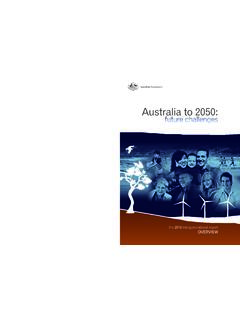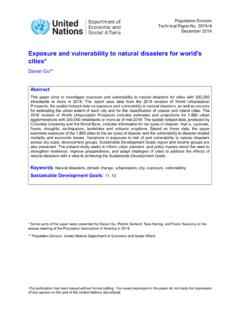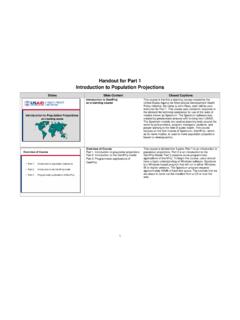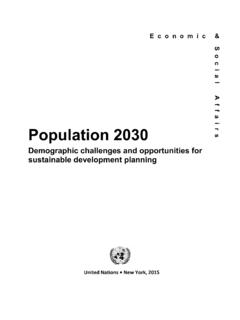Transcription of The Digitization of the World from Edge to Core
1 The Digitization of the WorldFrom Edge to CoreDavid Reinsel John Gantz John RydningAn IDC White Paper #US44413318, Sponsored byNovember 2018 ANALYZE THE FUTUREIDC White Paper I Doc# US44413318 I November 2018 The Digitization of the World From Edge to Core I 2 Executive SummaryThis process of Digitization is often referred to as digital transformation, and it is profoundly changing the shape of business today, impacting companies in every industry and consumers around the World . Digital transformation is not about the evolution of devices (though they will evolve), it is about the integration of intelligent data into everything that we do. The data-driven World will be always on, always tracking, always monitoring, always listening, and always watching because it will be always learning.
2 What we perceive to be randomness will be bounded into patterns of normality by sophisticated artificial intelligence algorithms that will deliver the future in new and personalized ways. Artificial intelligence will drive even more automation into businesses and feed processes and engagements that will deliver new levels of e ciency and products that are tailored to business outcomes and individual customer paradigms will be redefined (like vehicle or white goods ownership) and ethical, moral and societal norms will be challenged as genomics and advanced DNA profiling influence healthcare directives, insurance premiums, and spousal choices. Entertainment will literally be transformed before our eyes as virtual reality technologies transport us into new digital realities and augmented reality will dramatically change the service industry as we know it is on a quest todigitize the worldThe data-driven World will be always on, always tracking, always monitoring, always listening and always watching because it will be always focus of this Digitization is anything and everything that intersects our business workflows and personal streams of life.
3 IDC predicts that the Global Datasphere will grow from175 Zettabytesby 2025in 2018 to33 ZettabytesCloud is the new core One of the key drivers of growth in the core is the shift to the cloud from traditional datacenters. As companies continue to pursue the cloud (both public and private) for data processing needs, cloud datacenters are becoming the new enterprise data repository. In essence, the cloud is becoming the new core. In 2025 IDC predicts that 49% of the World s stored data will reside in public cloud the World 's first data readiness condition (DATCON) index Not all industries are prepared for their digitally transformed future. So, to help companies understand their level of data readiness, IDC developed a DATCON (DATa readiness CONdition) index, designed to analyze various industries regarding their own Datasphere, level of data management, usage, leadership, and monetization capabilities.
4 IDC examined four industries as part of its DATCON analysis: financial services, manufacturing, healthcare, and media and entertainment. Manufacturing s Datasphere is by far the largest given its maturity, investment in IoT, and 24x7 operations, and we found that manufacturing and financial services are the leading industries in terms of maturity, with media and entertainment most in need of a jump start. China's Datasphere on pace to becoming the largest in the World Every geographic region has its own Datasphere size and trajectories that are impacted by population , digital transformation progress, IT spend and maturity, and many other metrics. For example, China s Datasphere is expected to grow 30% on average over the next 7 years and will be the largest Datasphere of all regions by 2025 (compared to EMEA, APJxC, , and Rest of World ) as its connected population grows and its video surveillance infrastructure proliferates.
5 (APJxC includes Asia-Pacific countries, including Japan, but not China.)Consumers are addicted to data, and more of it in real-timeAs companies increase the Digitization of their business and drive consistent and better customer experiences, consumers are embracing these personalized real-time Data is at the heart of digital transformation, the lifeblood of this Digitization process. Today, companies are leveraging data to improve customer experiences, open new markets, make employees and processes more productive, and create new sources of competitive advantage working toward the future of tomorrow. Global Datasphere expansion is never-ending IDC has defined three primary locations where Digitization is happening and where digital content is created: the core (traditional and cloud datacenters), the edge (enterprise-hardened infrastructure like cell towers and branch o ces), and the endpoints (PCs, smart phones, and IoT devices).
6 The summation of all this data, whether it is created, captured, or replicated, is called the Global Datasphere, and it is experiencing tremendous growth . IDC predicts that the Global Datasphere will grow from 33 Zettabytes (ZB) in 2018 to 175 ZB by keep up with the storage demands stemming from all this data creation, IDC forecasts that over 22 ZB of storage capacity must ship across all media types from 2018 to 2025, with nearly 59% of that capacity supplied from the HDD enterprise renaissance is on the horizonThe enterprise is fast becoming the World 's data In the recent past, consumers were responsible for much of their own data, but their reliance on and trust of today s cloud services, especially from connectivity, performance, and convenience perspectives, continues to increase while the need to store and manage data locally continues to decrease.
7 Moreover, businesses are looking to centralize data management and delivery ( , online video streaming, data analytics, data security, and privacy) as well as to leverage data to control their businesses and the user experience ( , machine-to-machine communication, IoT, persistent personalization profiling). The responsibility to maintain and manage all this consumer and business data supports the growth in cloud provider datacenters. As a result, the enterprise s role as a data steward continues to grow, and consumers are not just allowing this, but expecting it. Beginning in 2019, more data will be stored in the enterprise core than in all the World 's existing and resetting their expectations for data delivery. As their digital World overlaps with their physical realities, they expect to access products and services wherever they are, over whatever connection they have, and on any device.
8 They want data in the moment, on the go, and personalized. This places greater demand on both the edge and the core to be able to produce the precise data consumers require, often in real-time. IDC predicts that due to the infusion of data into our business workflows and personal streams of life, that nearly 30% of the Global Datasphere will be real-time by 2025. Enterprises looking to provide superior customer experience and grow share must have data infrastructures that can meet this growth in real-time , more than 5 billion consumers interact with data every day by 2025, that number will be 6 billion, or 75% of the World 's population . In 2025, each connected person will have at least one data interaction every 18 seconds. Many of these interactions are because of the billions of IoT devices connected across the globe, which are expected to create over 90ZB of data in White Paper I Doc# US44413318 I November 2018 The Digitization of the World From Edge to Core I 3 Cloud is the new core One of the key drivers of growth in the core is the shift to the cloud from traditional datacenters.
9 As companies continue to pursue the cloud (both public and private) for data processing needs, cloud datacenters are becoming the new enterprise data repository. In essence, the cloud is becoming the new core. In 2025 IDC predicts that 49% of the World s stored data will reside in public cloud the World 's first data readiness condition (DATCON) index Not all industries are prepared for their digitally transformed future. So, to help companies understand their level of data readiness, IDC developed a DATCON (DATa readiness CONdition) index, designed to analyze various industries regarding their own Datasphere, level of data management, usage, leadership, and monetization capabilities. IDC examined four industries as part of its DATCON analysis: financial services, manufacturing, healthcare, and media and entertainment.
10 Manufacturing s Datasphere is by far the largest given its maturity, investment in IoT, and 24x7 operations, and we found that manufacturing and financial services are the leading industries in terms of maturity, with media and entertainment most in need of a jump start. China's Datasphere on pace to becoming the largest in the World Every geographic region has its own Datasphere size and trajectories that are impacted by population , digital transformation progress, IT spend and maturity, and many other metrics. For example, China s Datasphere is expected to grow 30% on average over the next 7 years and will be the largest Datasphere of all regions by 2025 (compared to EMEA, APJxC, , and Rest of World ) as its connected population grows and its video surveillance infrastructure proliferates. (APJxC includes Asia-Pacific countries, including Japan, but not China.)

















